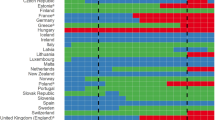Abstract
Over the past 20 years, most European countries have introduced DRGs or similar grouping systems as instruments for hospital reimbursement. This paper compares and analyzes the methods used to determine prices for inpatient care within DRGs or similar grouping systems employed in nine EU member states (i.e. Denmark, France, Germany, Hungary, Italy, the Netherlands, Poland, Spain and England). It categorizes the systems of patient classification used in these nine countries and compares them according to the three steps necessary in order to set prices: 1.) definition of a data sample, 2.) use of trimming methods and plausibility checks and 3.) definition of prices. It concludes with a discussion on the typical development path of DRG systems and the role of additional reimbursement components in this context.
Similar content being viewed by others
References
Averill RF, Muldoon JH, Vertrees JC, Goldfield NI, Mullin RL, Fineran EC, Zhang M, Steinbeck B, Grand T (1998) The evolution of casemix measurement using diagnosis related groups (DRGs) (3M HIS Research Report)
Canadian Institute for Health Information (2004) Acute care grouping methodologies: from diagnosis related groups to case mix groups redevelopment. Canadian Institute for Health Information, Ottawa
Fetter RB (1991) Diagnosis related groups: understanding hospital performance. Interfaces 21(1):6–26
Bellanger MM, Tardif L (2006) Accounting and reimbursement schemes for inpatient care in France. Health Care Manage Sci 9
Gaal P, Stefka N, Nagy J (2006) Cost accounting methodologies in price setting of acute inpatient services in Hungary. Health Care Manage Sci 9
Epstein D, Mason A (2006) Costs and prices for inpatient care in England: mirror twins or distant cousins. Health Care Manage Sci 9
Fattore G, Torbica A (2006) Inpatient reimbursement system in Italy: how do tariffs relate to costs. Health Care Manage Sci 9
Sánchez-Martínez F, Abellán-Perpiñán JM, Martínez-Pérez J-E, Puig-Junoy J (2006) Cost accounting and public reimbursement schemes in Spanish hospitals. Health Care Manage Sci 9
Ankjær-Jensen A, Rosling P, Bilde L (2006) Cost weights in the Danish case-mix system. Health Care Manage Sci 9
Schreyögg J, Tiemann O, Busse R (2006) Cost accounting to determine prices: how well do prices reflect costs in the German DRG-system. Health Care Manage Sci 9
Kozierkiewicz A, Stamirski M, Stylo W, Trąbka W (2006) The definition of inpatient care costs of universal health insurance in Poland. Health Care Manage Sci 9
Oostenbrink JB, Rutten FFH (2006) Cost assessment and price setting of inpatient care in the Netherlands. The DBC case-mix system. Health Care Manage Sci 9
Baker JJ (2002) Medicare payment system for hospital inpatients: diagnosis-related groups. J Health Care Finance 28(3):1–13
Schreyögg J, Tiemann O, Busse R (2005) The DRG reimbursement system in Germany. Euro Observer 7(4)
Busse R, Riesberg A (2004) Health care systems in transition—Germany. European Observatory on Health Systems and Policies, Copenhagen
Lungen M, Lapsley I (2003) The reform of hospital financing in Germany: an international solution? Journal of Health Organization and Management 17:360–372
Cots F, Castells X, Elvira D, Saez M (2003) Relevance of outlier cases in case mix systems and evaluation of trimming methods. Health Care Manage Sci 6:27–35
Lichtig LK (1986) Hospital information systems for casemix management. Wiley, New York
Briggs A, Gray A (1998) The distribution of health care costs and their statistical analysis for economic evaluation. J Health Serv Res Policy 3:233–245
Cots F, Mercade L, Castells X, Salvador X (2004) Relationship between hospital structural level and length of stay outliers. Health Policy 68:159–168
Lee AH, Fung WK, Wing K, Fu B (2003) Analyzing hospital length of stay: mean or median regression? Med Care 41:681–686
Paddock SM, Wynn BO, Carter GM, Buntin MB (2004) Identifying and accommodating statistical outliers when setting prospective payment rates for inpatient rehabilitation facilities. Health Serv Res 39:1859–1880
Hensen P, Fürstenberg T, Luger TA, Steinhoff M, Roeder N (2005) Case mix measures and diagnosis-related groups: opportunities and threats for inpatient dermatology. J Eur Acad Dermatol Venereol 19:582–588
Antioch KM, Walsh MK (2004) The risk-adjusted vision beyond casemix (DRG) funding in Australia. Eur J Health Econ 5:95–109
Bilde L, Ankjaer-Jensen A, Danneskiold-Samsoe B (2005) The health benefit basket in Denmark: a description of entitlements, actors and decision-making processes in the curative health sector. Eur J Health Econ 6:S11–S17
Torbica A, Fattore G (2005) The essential levels of care in Italy: when being explicit serves the devolution of powers. Eur J Health Econ 6:S46–S52
Schreyögg J, Stargardt T, Velasco-Garrido M, Busse R (2005) Defining the “Health Benefit Basket” in nine European countries. Evidence from the European Union Health BASKET Project. Eur J Health Econ 6:S2–S10
Ben-Tovim DI, Elzinga RB (1994) Making casemix work for psychiatry. Med J Aust 161:S33–S36
Thorpe KE, Cretin S, Keeler PB (1988) Are the diagnosis-related group case weights compressed. Health Care Financ Rev 10(2):37–46
Taheri PA, Butz DA, Dechert R, Greenfield LJ (2001) How DRGs hurt academic health systems. J Am Coll Surg 193:1–8
Horn SD, Bulkley G, Sharkey PD, Chambers AF, Horn RA, Schramm CJ (1985) Interhospital differences in severity of illness, problems for prospective payment based on diagnosis-related groups (DRGs). N Engl J Med 313:20–24
Cots F, Castells X, Dalmau E (2000) Medicare’s DRG-weights in a European environment: the Spanish experience. Health Policy 51:31–47
Author information
Authors and Affiliations
Corresponding author
Rights and permissions
About this article
Cite this article
Schreyögg, J., Stargardt, T., Tiemann, O. et al. Methods to determine reimbursement rates for diagnosis related groups (DRG): A comparison of nine European countries. Health Care Manage Sci 9, 215–223 (2006). https://doi.org/10.1007/s10729-006-9040-1
Published:
Issue Date:
DOI: https://doi.org/10.1007/s10729-006-9040-1




